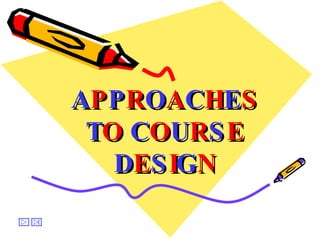
Course Design Approaches
- 1. A P P R O A C H E S T O C O U R S E D E S I G N
- 2. WHAT IS A “COURSE DESIGN”? It is the process by which the raw data about a learning need is interpreted to produce an integrated series of teaching-learning experiences . WHAT IS ITS AIM? To lead the learners to a particular state of knowledge. This entails the use of the theoretical and empirical information available to produce a syllabus, to develop a methodology for teaching those materials and to establish evaluation procedures by which progress towards the specified goals will be measured. What learners need and want may conflict. We must remember that there are external constraints (classroom facilities/ time) that will restrict what is possible. We also have to take into account our own theoretical views and experiences of the classroom . There are many different approaches to ESP course design .
- 3. 1. LG-CENTRED COURSE DESIGN It is the simplest and more familiar kind to English teachers (Ts). It aims to draw as direct a connection as possible between the analysis of the target situation and the content of the ESP course. It proceeds as follows:
- 4. However, it has a number of weaknesses: 1. It starts from the learner and their needs . It might be considered a learner-centred approach. The learner is simply used as a means of identifying the target situation. 2. It is a static and inflexible procedure, which can take little account of the conflicts and contradictions that are inherent in any human endeavour. 3. It appears to be systematic . 4. It gives no acknowledgement to factors which must inevitably play a part in the creation of any course. Data is not important in itself . 5. The lg-centred analysis of target situation data is only at the surface level . It reveals very little about the competence that underlies the performance. This course design fails to recognise the fact that, learners being people, learning is not a straightforward, logical process. A lg-centred approach says: ‘ This is the nature of the target situation performance and that will determine the ESP course.’
- 7. A skills-centred approach says: ‘we must look behind the target performance data to discover what processes enable sb to perform. Those processes will determine the ESP course.’ Identify target situation Theoretical views of lg Theoretical views of learning Analyse skills/ strategies required to cope in target situation Select texts and write exercises to focus on skills/ strategies in syllabus Write syllabus Establish evaluation procedures which require the use of skills / strategies in syllabus
- 9. A learning-centred approach says: ‘we must look beyond the competence that enables sb to perform, because what we really want to discover is not the competence itself, but how sb acquires that competence.’ Identify target situation Analyse target situation Analyse learning situation Write syllabus Write materials Teach materials Evaluate learner achievements A lg- centred approach considers the learner to here. A skills- centred approach considers the learner to here. A learning- centred approach must consider the learner at every stage
- 11. The learning-centred course design process is shown in this diagram: Identify learners Theoretical views of learning Analyse learning situation Analyse target situation Theoretical view of lg Identify attitudes/ wants/ potential of learners dentify needs/ potential/ constraints of learning/ teaching situation Identify skills and knowledge needed to function in the target situation Write syllabus/ materials to exploit the potential of the learning situation in the acquisition of the skills and knowledge required by the target situation. Evaluation Evaluation